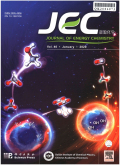- 钛学术文献服务平台 \
- 学术期刊 \
- 工业技术期刊 \
- 石油与天然气工业期刊 \
- 能源化学期刊 \
Lithiated Nafion-garnet ceramic composite electrolyte membrane for solid-state lithium metal battery
Lithiated Nafion-garnet ceramic composite electrolyte membrane for solid-state lithium metal battery
基本信息来源于合作网站,原文需代理用户跳转至来源网站获取
摘要:
Single-ion conducting solid polymer electrolytes are expected to play a vital role in the realiza-tion of solid-state Li metal batteries. In this work, a lithiated Nafion (Li-Nafion)-garnet ceramic Li6.25La3Zr2Al0.25O12 (LLZAO) composite solid electrolyte (CSE) membrane with 30 μm thickness was pre-pared for the first time. By employing X-ray photoelectron spectroscopy and transmission electron mi-croscope, the interaction between LLZAO and Li-Nafion was investigated. It is found that the LLZAO inter-acts with the Li-Nafion to form a space charge layer at the interface between LLZAO and Li-Nafion. The space charge layer reduces the migration barrier of Li-ions and improves the ionic conductivity of the CSE membrane. The CSE membrane containing 10 wt% LLZAO exhibits the highest ionic conductivity of 2.26 × 10- 4 S cm- 1 at 30 ℃ among the pristine Li-Nafion membrane, the membrane containing 5 wt%, 20 wt%, and 30 wt% LLZAO, respectively. It also exhibits a high Li-ion transference number of 0.92, and a broader electrochemical window of 0–+ 4.8 V vs. Li+ /Li than that of 0–+ 4.0 V vs. Li+ /Li for the pristine Li-Nafion membrane. It is observed that the CSE membrane not only inhibits the growth of Li dendrites but also keeps excellent electrochemical stability with the Li electrode. Benefitting from the above merits, the solid-state LiFePO4/Li cell fabricated with the CSE membrane was practically charged and discharged at 30 ℃. The cell exhibits an initial reversible discharge specific capacity of 160 mAh g- 1 with 97% ca-pacity retention after 100 cycles at 0.2 C, and maintains discharge specific capacity of 126 mAh g- 1 after 500 cycles at 1 C. The CSE membrane prepared with Li-Nafion and LLZAO is proved to be a promising solid electrolyte for advanced solid-state Li metal batteries.

推荐文章
Diffusion in garnet: a review
High temperature and high pressure
Diffusion
Garnet
Point defects
Synthesis of zinc oxide–montmorillonite composite and its effect on the removal of aqueous lead ions
Synthesis
Characterization
Zinc oxide–montmorillonite composite
Adsorption, Pb2+ ions
Test the topographic steady state in an active mountain belt
Taiwan
Uplift
Denudation
River profile
Sediment yield
In-situ 10Be
内容分析
关键词云
关键词热度
相关文献总数
(/次)
(/年)
引文网络
引文网络
二级参考文献 (0)
共引文献 (0)
参考文献 (67)
节点文献
引证文献 (0)
同被引文献 (0)
二级引证文献 (0)
1901(1)
- 参考文献(1)
- 二级参考文献(0)
1985(1)
- 参考文献(1)
- 二级参考文献(0)
1987(1)
- 参考文献(1)
- 二级参考文献(0)
1995(1)
- 参考文献(1)
- 二级参考文献(0)
1999(1)
- 参考文献(1)
- 二级参考文献(0)
2000(1)
- 参考文献(1)
- 二级参考文献(0)
2003(1)
- 参考文献(1)
- 二级参考文献(0)
2004(1)
- 参考文献(1)
- 二级参考文献(0)
2007(1)
- 参考文献(1)
- 二级参考文献(0)
2011(1)
- 参考文献(1)
- 二级参考文献(0)
2012(2)
- 参考文献(2)
- 二级参考文献(0)
2013(2)
- 参考文献(2)
- 二级参考文献(0)
2014(4)
- 参考文献(4)
- 二级参考文献(0)
2015(3)
- 参考文献(3)
- 二级参考文献(0)
2016(7)
- 参考文献(7)
- 二级参考文献(0)
2017(11)
- 参考文献(11)
- 二级参考文献(0)
2018(17)
- 参考文献(17)
- 二级参考文献(0)
2019(11)
- 参考文献(11)
- 二级参考文献(0)
2020(0)
- 参考文献(0)
- 二级参考文献(0)
- 引证文献(0)
- 二级引证文献(0)
引文网络交叉学科
相关学者/机构
期刊影响力
能源化学
主办单位:
中国科学院大连化学物理研究所
中国科学院成都有机化学研究所
出版周期:
双月刊
ISSN:
2095-4956
CN:
10-1287/O6
开本:
出版地:
大连市中山路457号
邮发代号:
创刊时间:
语种:
eng
出版文献量(篇)
2804
总下载数(次)
0
总被引数(次)
7996
期刊文献
相关文献
推荐文献
- 期刊分类
- 期刊(年)
- 期刊(期)
- 期刊推荐
一般工业技术
交通运输
军事科技
冶金工业
动力工程
化学工业
原子能技术
大学学报
建筑科学
无线电电子学与电信技术
机械与仪表工业
水利工程
环境科学与安全科学
电工技术
石油与天然气工业
矿业工程
自动化技术与计算机技术
航空航天
轻工业与手工业
金属学与金属工艺
能源化学2022
能源化学2021
能源化学2020
能源化学2019
能源化学2018
能源化学2017
能源化学2016
能源化学2015
能源化学2014
能源化学2013
能源化学2012
能源化学2011
能源化学2010
能源化学2009
能源化学2008
能源化学2007
能源化学2006
能源化学2005
能源化学2004
能源化学2003
能源化学2002
能源化学2001
能源化学2020年第9期
能源化学2020年第8期
能源化学2020年第7期
能源化学2020年第6期
能源化学2020年第5期
能源化学2020年第4期
能源化学2020年第3期
能源化学2020年第12期
能源化学2020年第11期
能源化学2020年第10期
能源化学2020年第1期

 免费查重
免费查重










